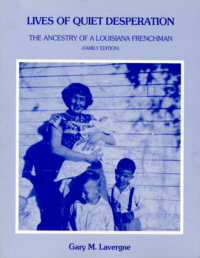While sitting on
the front steps of a very modest home in the small Cajun community of Church
Point in Louisiana, Nolan Lavergne talked to his son about the happiness
and hardships of growing up on a tenant farm in rural St. Landry Parish.
His son was a rookie high school American History teacher who asked a seemingly
simple question: "Who was your grandfather?" The father did not
know. "Well, Daddy, I'm going to find out for you," said the son. Thus began a fourteen-year-long project culminating in
Lives of
Quiet Desperation, a look at the ancestry of Gary M. Lavergne,
a Louisianian of French descent. In addition to a substantial genealogy
with over 1,200 names, Lavergne includes a series of concise essays placing
generations in historical context. Special treatment is given to the forces
that helped to determine the migrations of various groups of French-speaking
people, and the pioneers who helped to build new worlds in Canada and French
Louisiana. Particular emphasis is placed upon defining and describing the
differences between Cajuns, Creoles, and other Louisiana French cultures. The vast majority of the ancestors were simple, poor, tenant farmers
with large cohesive families. the uncommon were pioneers of note. they
all faced considerable odds and led lives of quiet desperation.
This page is an excerpt of LIVES OF QUIET DESPERATION
and is made available to the public. However, Gary M. Lavergne retains copyright and
all rights are reserved. Eugene Lavergne's
Amnesty Oath Unlike the Civil War itself, the war in Louisiana was relatively
quick and decisive. Once Admiral David Farragut captured New Orleans --
Louisiana, as a Confederate state was no more. The subsequent "Battles
of the Bayou Country" were more attempts to prevent an invasion of
Texas than a defense of the Bayou State. By living in between Texas and
New Orleans, Cajuns and other French Louisianians were caught in the middle;
geography brought the Civil War to Acadiana. As a young man of 19 at the
end of the war, Eugene Lavergne had witnessed the military struggle as
an adolescent, and was forced to deal with Reconstruction as a young adult.
The Lavergnes were never wealthy owners of vast tracts of land, and not
likely to ever have owned more than one or two, if any, slaves. They were
simple tenant farmers and never part of the opulence of the Antebellum
South. In July, 1862, Congress passed an act providing for the confiscation
of the property of disloyal persons. It allowed sixty days for these persons
to return to their proper loyalty to the United States. Normally, this
was done through a "Loyalty Oath." In September, General Benjamin
Butler, the commanding Union officer in New Orleans ordered all persons
who refused to take the loyalty oath to be registered as enemies and to
provide a list of their property. About 4,000 people registered as enemies,
but more than 61,000 swore a loyalty oath. By war's end in 1865 many young
men, including Eugene Lavergne, were appearing in courthouses to receive
amnesty and to solemnly swear to: 1. faithfully defend the Constitution of the United States; 2. support the Union of States; and 3. support the Proclamations and laws passed by Congress during the
war. Union officials were interested in having the men of the area renounce
the institution of slavery, and more specifically, to accept Abraham Lincoln's
Emancipation Proclamation, which freed slaves in Confederate-held lands
as of 1 January 1863. On 19 August 1865, less that a month before his marriage to Marie
Hermine Bourgeois, Eugene Lavergne appeared before L.V. Chachere, a St.
Landry Parish clerk, and swore a loyalty oath. He might have done so in
order to secure a marriage license, or to protect whatever property he
did own, or just to get the whole messy affair over with. REFERENCE ESSAYS PICTURES
| Gary's Bio
|Before Brown| Worse
Than Death| Bad Boy From Rosebud |
Sniper in the Tower | Cajuns
|



